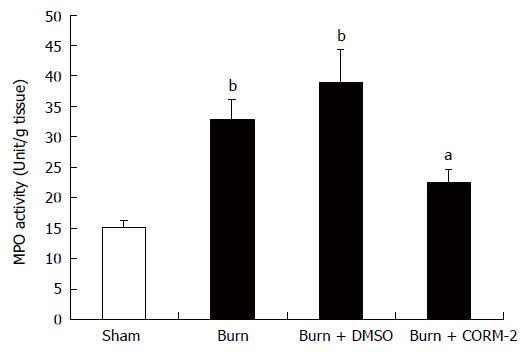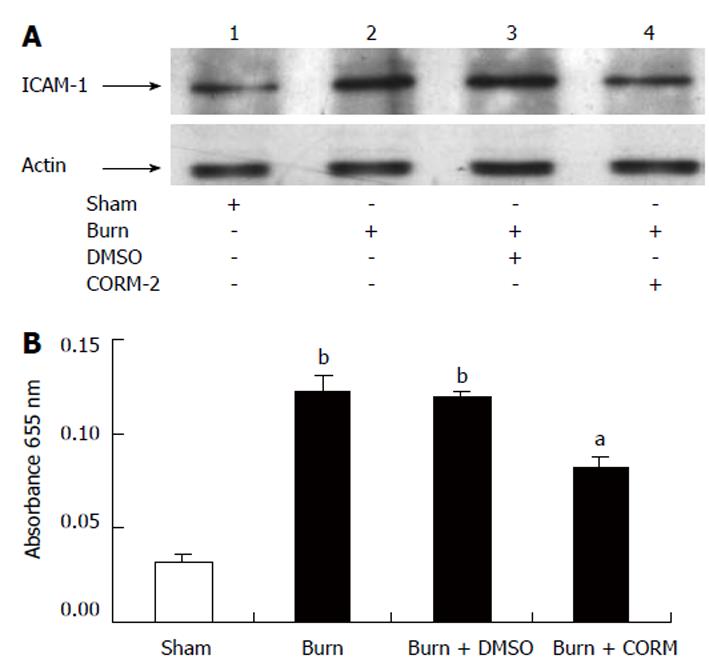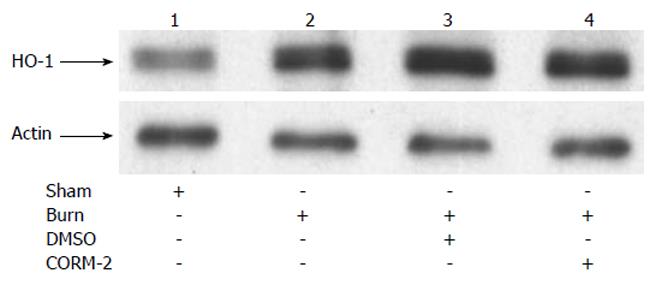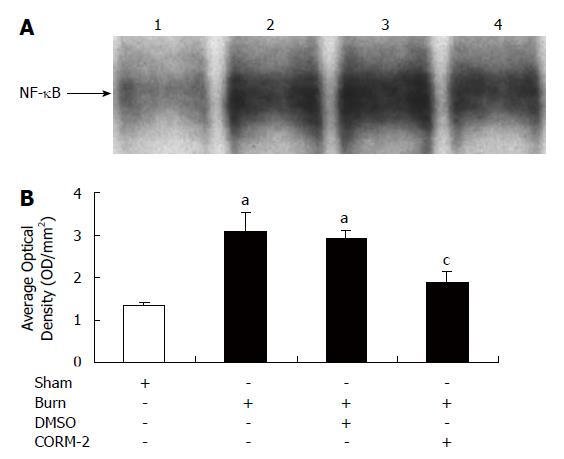Copyright
©2007 Baishideng Publishing Group Inc.
World J Gastroenterol. Dec 14, 2007; 13(46): 6183-6190
Published online Dec 14, 2007. doi: 10.3748/wjg.v13.i46.6183
Published online Dec 14, 2007. doi: 10.3748/wjg.v13.i46.6183
Figure 1 Effects of CORM-2 on small intestine injury in thermally injured mice.
Mice were injected i.v. with CORM-2 (8 mg/kg) immediately after thermal injury. Mice in the DMSO group received a 160-μL bolus injection of 0.5% DMSO/saline. Mid-ileum sections from sham-treated mice had normal architecture of the intestinal epithelium and wall (A); Mid-ileum sections from thermally injured mice showed inflammatory cell infiltration through the wall, concentrated below the epithelial layer, edema of the distal portion of the villi, and necrosis of the epithelium at the villous tips (B); Ileum section from burned mice treated with CORM-2 (C) showed a significant decrease in granulocyte infiltration, while no marked improvement of hydropic degeneration. The figure is representative of at least three experiments performed on different days.
Figure 2 Effects of CORM-2 on MPO activity in the small intestine of thermally injured mice.
Mice were challenged with thermal injury and treated with CORM-2 as described in Figure 1. MPO activity in the mid-ileum was assessed 24 h following thermal injury. Results are mean ± SE, bP < 0.01 vs sham mice. aP < 0.05 vs burned mice.
Figure 3 Effects of CORM-2 on protein expression of ICAM-1 in the ileum tissue of thermally injured mice.
Mice were challenged with thermal injury and treated with CORM-2 as described in Figure 1. Protein expression of ICAM-1 was analyzed by Western blotting (A) and ELISA (B) 24 h after thermal injury. A representative experiment is shown in A. bP < 0.01 vs sham-treated; aP < 0.05 vs burned mice.
Figure 4 Effects of CORM-2 on protein expression of HO-1 in the ileum tissue of thermally injured mice.
Mice were challenged with thermal injury and treated with CORM-2 as described in Figure 1. Protein expression of HO-1 was performed by Western blotting 24 h after thermal injury. A representative experiment showed that HO-1 was significantly up-regulated by thermal injury (lane 2). Expression of HO-1 in the small intestine of thermally injured mice treated with CORM-2 was more significantly increased compared to burned mice without CORM-2 (lane 4).
Figure 5 Effects of CORM-2 on NF-κB activation in the ileum tissue of thermally injured mice.
Mice were challenged with thermal injury and treated with CORM-2 as described in Figure 1. Measurement of NF-κB activity was performed by EMSA with 32P-labeled NF-κB probe and 5 μg nuclear extract from the ileum of sham, burn, burn + DMSO and burn+CORM-2 mice at 24 h after thermal injury. NF-κB activation in the ileum of thermally injured mice was markedly increased (lane 2), and this activity was inhibited by CORM-2 (lane 4). A representative experiment is shown in A, and quantitative results (average optical density) of three experiments are shown in B. aP < 0.05 vs sham-treated; cP < 0.05 vs burned.
- Citation: Sun BW, Jin Q, Sun Y, Sun ZW, Chen X, Chen ZY, Cepinskas G. Carbon liberated from CO-releasing molecules attenuates leukocyte infiltration in the small intestine of thermally injured mice. World J Gastroenterol 2007; 13(46): 6183-6190
- URL: https://www.wjgnet.com/1007-9327/full/v13/i46/6183.htm
- DOI: https://dx.doi.org/10.3748/wjg.v13.i46.6183













